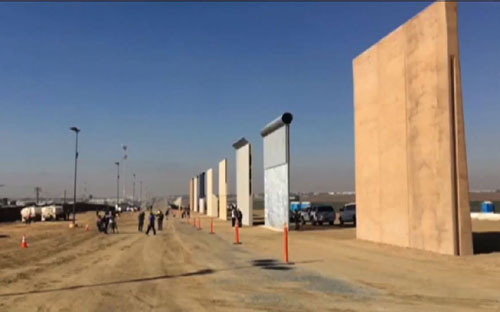by WorldTribune Staff, February 18, 2019
The law which gives the Trump administration the authority to build a barrier on the U.S.-Mexico border was signed into law by President Barack Obama on Dec. 23, 2016.
In November 2016, not long after Donald Trump was elected president, Congress passed 10 U.S.C § 284. The statute authorizes the secretary of defense to support the “construction of roads and fences and installation of lighting to block drug smuggling corridors across international boundaries of the United States.”

Obama signed the bill into law without any objection to the border barrier provision.
On Feb. 15, the Trump administration invoked 10 U.S.C § 284. Trump identified up to $2.5 billion in Department of Defense funds that were designated for counter-drug activities.
Related: 3,000 sheriffs warn immigration deal threatens nation’s security, Feb. 12, 2019
“This provision does not turn on the declaration of a national emergency pursuant to 10 U.S.C. § 2808, which the president also invoked in a proclamation issued the same day,” Josh Blackman, associate professor at the South Texas College of Law Houston, wrote for Lawfare.
“Critically, the White House stated that ‘these funding sources will be used sequentially and as needed.’ The ’emergency’ funds may not be tapped until the other, less controversial funds are depleted. Plaintiffs may not have standing to challenge the diversion of ’emergency’ funds until those funds are in fact allocated. Through § 284, both Houses of Congress willingly gave President Trump a path to build at least part of the wall,” Blackman wrote.
Blackman, who is not a fan of the president’s move, saying he considers Trump’s decision “awful” policy, wrote that Congress “cannot claim that the president is subverting the rule of law when it gives him the precise authority he needs to accomplish his goal. In January 2017, Democratic Senator Jack Reed said that Congress could block the president from relying on this statute to fund the fence – and certainly that could work prospectively. But Congress is responsible for enacting this statute in the first place.”
According to acting White House chief of staff Mick Mulvaney, Trump is seeking roughly $8 billion for the border wall – $3.6 billion from 10 U.S.C. § 2808, which is tied to the national emergency; $2.5 billion from 10 U.S.C. § 284, which is Department of Defense money moved to counter-drug funds; $1.4 billion from the fiscal 2018 funding bill; and $600 million from the Treasury forfeiture fund.
“Obviously, it’s left to the courts to decide whether Trump’s national emergency will hold,” Siraj Hashmi wrote in a Feb. 15 op-ed for the Washington Examiner. “Seeing as how his national emergency only counts for a percentage of the funding, it looks like Trump will at least get some parts of the wall built.”
House Freedom Caucus Chairman Mark Meadows, North Carolina Republican, had last month said Trump could invoke 10 U.S.C § 284.
Meadows tweeted on Jan. 20: “Democrats have made it extremely clear this shutdown is all about opposing Trump for them. It’s time to pursue other options. 10 USC 274/284 would allow for fence construction without national emergency. Protect our communities, build the wall, and forget unreasonable Democrats.”
Check Out Geostrategy-Direct __________ Jump Start the U.S. Media
